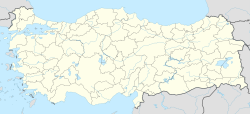world.wikisort.org - Turkey
Üçdere is a village in central Muş, Eastern Anatolia Region, Turkey.[1] It is located 6 kilometers from the center of Muṣ. As of 2000, Üçdere has a population of 854.
Üçdere | |
|---|---|
Village | |
 Üçdere | |
| Coordinates: 38°44′00″N 41°29′28″E | |
| Country | Turkey |
| Province | Muş |
| Population (2000) | |
| • Total | 854 |
| Website | Üçdere |
History
Human settlement has been present in the Mus plain for about 10,000 years. During the Middle Ages, Muṣ was the center of the Taron kingdom. In the late 8th century, the area came under the control of the Armenian Bagratid (Bagratuni) dynasty, until it was captured and annexed by the Byzantine Empire in 969.[2] In the 11th century, the town was ruled by Islamic dynasties such as the Ahlatshahs. In the 1500s, the Ottomans took control of the area. During the Armenian genocide of 1915, the indigenous Armenian population of the region was exterminated.[3] The town was formerly known as Tsoghounk, until World War I. The town was occupied by the Russian Empire in 1916 and was recaptured by Turkish troops on 30 April 1917.
Today, the economy of the village depends on agriculture and animal husbandry. There is a primary school, electricity and landline telephone in the village.
A number of ruins dot the landscape near the village including the Arakelots Monastery, Surp Marineh Church, Mush, Surb Karapet Monastery. Mosques like the Alaeddin Bey (18th century),[4] Haci Seref (17th century),[4] and Ulu Mosque (14th century).[4] Caravanserai such as the "Yıldızlı Han" (13th century) which was destroyed in 1916 and the now almost completely ruined "Arslanli Han"[4] can be found in the area. The bathhouse and fountain of Alaeddin Bey as well as the tombs of Muslim saints are also located around Üçdere.
Climate
Üçdere has a hot summer Mediterranean continental climate (Köppen climate classification Dsa) with freezing, snowy winters and hot, very dry and very sunny summers.
| Climate data for Muş (1960-2012) | |||||||||||||
|---|---|---|---|---|---|---|---|---|---|---|---|---|---|
| Month | Jan | Feb | Mar | Apr | May | Jun | Jul | Aug | Sep | Oct | Nov | Dec | Year |
| Record high °C (°F) | 10.2 (50.4) |
15.0 (59.0) |
22.8 (73.0) |
30.0 (86.0) |
31.2 (88.2) |
37.4 (99.3) |
41.6 (106.9) |
41.2 (106.2) |
37.0 (98.6) |
30.6 (87.1) |
21.6 (70.9) |
16.0 (60.8) |
41.6 (106.9) |
| Average high °C (°F) | −3.2 (26.2) |
−1.5 (29.3) |
5.5 (41.9) |
14.4 (57.9) |
21.1 (70.0) |
27.3 (81.1) |
32.8 (91.0) |
32.9 (91.2) |
28.2 (82.8) |
19.8 (67.6) |
9.7 (49.5) |
0.9 (33.6) |
15.7 (60.2) |
| Daily mean °C (°F) | −7.4 (18.7) |
−6.0 (21.2) |
0.7 (33.3) |
9.0 (48.2) |
14.9 (58.8) |
20.3 (68.5) |
25.3 (77.5) |
25.2 (77.4) |
20.1 (68.2) |
12.6 (54.7) |
4.5 (40.1) |
−2.8 (27.0) |
9.7 (49.5) |
| Average low °C (°F) | −11.2 (11.8) |
−10.1 (13.8) |
−3.4 (25.9) |
4.0 (39.2) |
8.6 (47.5) |
12.5 (54.5) |
16.8 (62.2) |
16.6 (61.9) |
12.0 (53.6) |
6.6 (43.9) |
0.3 (32.5) |
−6.0 (21.2) |
3.9 (39.0) |
| Record low °C (°F) | −32.6 (−26.7) |
−34.4 (−29.9) |
−31.4 (−24.5) |
−10.2 (13.6) |
−2.4 (27.7) |
2.2 (36.0) |
3.6 (38.5) |
8.0 (46.4) |
2.0 (35.6) |
−3.0 (26.6) |
−25.8 (−14.4) |
−32.0 (−25.6) |
−34.4 (−29.9) |
| Average precipitation mm (inches) | 84.8 (3.34) |
100.4 (3.95) |
101.7 (4.00) |
106.9 (4.21) |
67.1 (2.64) |
26.3 (1.04) |
6.2 (0.24) |
3.8 (0.15) |
13.2 (0.52) |
62.5 (2.46) |
90.9 (3.58) |
89.0 (3.50) |
752.8 (29.63) |
| Average precipitation days | 13.2 | 12.3 | 13.7 | 14.5 | 13.6 | 6.3 | 2.0 | 1.5 | 3.0 | 9.0 | 10.0 | 12.5 | 111.6 |
| Mean monthly sunshine hours | 65.1 | 86.8 | 148.8 | 198 | 285.2 | 354 | 387.5 | 372 | 315 | 226.3 | 129 | 65.1 | 2,632.8 |
| Percent possible sunshine | 21 | 29 | 40 | 50 | 64 | 80 | 86 | 88 | 84 | 65 | 43 | 22 | 59 |
| Source: Devlet Meteoroloji İşleri Genel Müdürlüğü[5] | |||||||||||||
References
- "Türkiye Köyleri | YerelNET". www.yerelnet.org.tr. Retrieved 2020-02-02.
- Thomas, David Richard (2001). Syrian Christians Under Islam: The First Thousand Years. BRILL. pp. 160. ISBN 9789004120556.
- Suny, Ronald G. (2015). "They Can Live in the Desert but Nowhere Else": A History of the Armenian Genocide. Princeton University Press. p. 289. ISBN 9781400865581.
- Sinclair, T.A. (1989). Eastern Turkey: An Architectural & Archaeological Survey, Volume I. Pindar Press. pp. 293–294–333–335. ISBN 9780907132325.
- İl ve İlçelerimize Ait İstatistiki Veriler- Meteoroloji Genel Müdürlüğü Archived 2011-04-30 at the Wayback Machine. Dmi.gov.tr. Retrieved on 2011-04-16.
Другой контент может иметь иную лицензию. Перед использованием материалов сайта WikiSort.org внимательно изучите правила лицензирования конкретных элементов наполнения сайта.
WikiSort.org - проект по пересортировке и дополнению контента Википедии